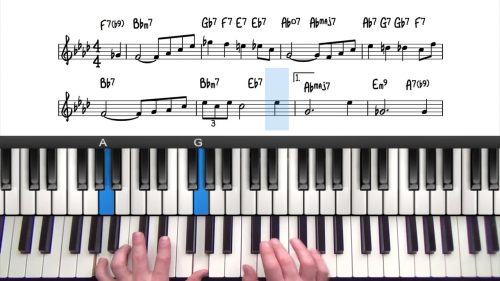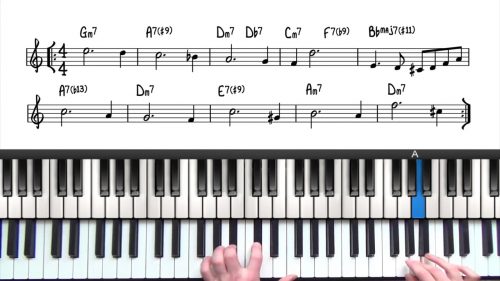2 Handed Comping – Open Position Rootless Voicings
Welcome to this lesson on Open Position Rootless Voicings. When playing with other jazz musicians, you will be required to perform different roles than when playing solo jazz piano.
One very important role is to provide harmonic support to the soloists throughout the performance. This is known as ‘comping’ which is short for ‘accompanying’.
When playing in a band, you will likely have a bass player present who will have the roots of each chord covered. This frees you up to play more interesting harmony using rootless comping voicings.
Open vs. Closed Position Voicings
We’re going to cover some useful techniques the best possible sound from rootless voicings in an ensemble setting. We can take any rootless voicing and spread the notes over 2 hands to create open position rootless voicings.
Before watching this lesson, you should have a good understanding of basic rootless voicings and you should be able to play through the whole form of TWNBAY with these voicings in your left hand.
Extending Open Position Voicings
In addition to open position, we’ll also extend basic rootless voicings with stacked 4ths and 5ths to create a bigger sound. In the next lesson, we will introduce more quartal voicings and cover a number of useful 251 voicing sets made of 4th intervals.
Practice Tips
-
With open position voicings, keeping the 'guide tones' in your left hand creates a strong harmonic foundation.
-
Remember to experiment with the different alterations and extensions in your right hand.
-
To start with it you may find it difficult to visualize left-hand voicings in this position. Take the time to analyse the notes and make sure that you can see the voice movement.
-
For extended voicings, visualize the comping voicings in 2 parts, split between my left and right hand.
-
A great place to start with this is to play rootless voicings in your left hand and then stack 4th or 5th intervals on top in your right hand
- Stacked 4ths are tonally ambiguous and so we can use that same stack over all the chords in a 251 in Eb Major.







Hi. When playing a 4 note voicing, for a maj 6 chord do you play 3 and 6 in left hand, 5 and 9 in right?
Same question for minor 6. b3 and 6 in left, not b3 and b7.
Thanks
Chris kaiser
Hi Hayden,
Is it possible to get a cheat sheet for the voicings in this lesson (or is it contained somewhere else and just me missing it)?
Many thanks in advance,
and also, cheat sheet for the Quartal voicing of next lesson would be great.
Cheers,
Hi Peerapong,
Yes I can create a download which contains the voicings used in this lesson, and also the next lesson on quartal voicings.
I’m publishing some new lessons today and I will get started after that.
Cheers!
Hayden
I second this request! :-) It’s so much great information but overwhelming if we are new to comping, so some “cheat sheet” voicings for this lesson and the variations you covered, and the quartal voicings in the next lesson could get us started practicing in all 12 keys :-)
I always find the PDF files that accompany many of the lessons great aids and super helpful to “refresh” the material and practice in all 12 keys at the beginning of practice sessions instead of watching whole videos again.
Great lesson! I can see it’ll be super helpful after getting the hang of it. Thanks so much for your continued work on this website!
Hi Hayden,
Thanks for all this great content on comping – few quick questions:
1). Would you ever stack fourths of the type “B” style rootless voicing built of the 7th, with the stack of fourths starting off the 5th (basically the same stack of fourths you demonstrated on type “A” rootless voicing?
2.) When comping, would you ever choose to use regular LHRV’s? (Occasionally, often or never?) Or only when you want to add additional melody in the right hand?
3). When comping, do you always play each chord in the form, or would you ever not play a chord if the soloist is playing a busy section?
4). It seems like you’re aiming to play comping voicings in the center of the piano (or close the the center), and finding open/extended version that has the best frequencies. Would you say that’s accurate?
5). I assume the best way to practice these is to start applying them the standards. What I’m doing so far is going through some tunes, practicing both the simple open LHRV’s, and then some with 5/6 note extensions similar to the examples you showed, and then playing them over a record or backing track. Would you say I’m on the right track here? Or would you recommend another way to practice these?
Thanks!
Best,
Clif
Hi Clif,
Great questions here.
Firstly incase you haven’t seen, we have a new type of comping demonstration lesson created by Tuomo, you can see the first one here on Autumn Leaves: community.pianogroove.com/t/jazz-standards-comping-improvisation/7911
We have lessons on “There Will Never Be Another You” and “The Days Of Wine & Roses” coming shortly.
Check out the lesson referenced in the thread above and you will see a lot of the principles from this course applied in context of a real accompaniment.
To answer your questions:
Yes we can use the Type B voicing as the foundation for this voicing type. However, the Type A voicing gives a better spread on the piano to create a more open sound. You can experiment with both but I would recommend learning the Type A voicing starting position first.
Yes I always use regular left hand voicings in my comping. Sometimes I will play them on their own, and sometimes I will stack 4ths or 5ths on top with my right hand. Stacking 5ths on top creates the Red Garland Voicings, check out the lesson on that topic here: pianogroove.com/jazz-piano-lessons/red-garland-voicing-block-chord-tutorial/
When practicing with a backing track I tend to play most of the chords. In real performance sometimes the most effective thing to do is leave space in our comping. It very much depends on what is going on in the band but certainly leaving space is part of the compers toolset.
Yes when we are playing rootless voicings, they tend to sound best right around middle C. Of course we can play our voicings higher or lower, but this is the ‘sweet spot’ to aim for. Check out Tuomo’s performance video over “Autumn Leaves”.
Yes absolutely the best way to practice this stuff is in context of tunes. Use backing track software and cycle around and around the form. Firstly map out your comping voicings, and then start to add more spontaneity by stacking up voicings, changing inversions etc…
Finally the ultimate practice for this stuff is with other musicians. Aim to have a handful of tunes where you can play these voicings without looking at the lead sheet, and then you are ready to jam with other musicians.
I hope that helps Cliff, if you post a comment in the comping thread, you will then be notified when we add more lessons. These lessons will create a full comping course and include the PDF transcription and the backing tracks.
Cheers,
Hayden
Awesome – thanks, Hayden. All this is really helpful.
I’ve watched of few of the comping videos you already put out a few times to get acclimated, so to speak, to the new style of voicings, extensions, and progressions. It was really helpful to map out the different ways to comp over 251’s, and especially playing along with the demonstration over a standard. I’m feeling much more comfortable with these now (the examples you showed in this video), and plan to soon get more familiar with the quartal voicings.
Really enjoyed Tuomo’s lesson! Wow, that sounds great, will definitely have to put some time studying that. At this level your more, say, beginner friendly style videos are a bit easier to follow along, so I can really take home the concepts going on with each example you show, digesting each one and then taking them into different keys over different songs. But I’m sure I’ll soon find Tuomo’s lesson valuable too as I take the time to dive into it. Definitely looking forward to any new comping content!
Thanks again,
Clif
Sind Papier Unterlagen von Lektionen erhältlich,,zB. solo piano seeds sowie Buch mit Jazzstücken und Zusammensetzung von gebuchten Kurs Lektionen.
Brauche mehr Informationen über den Umfang des Kurses on line, ich kann doch keine Seminare in Schweiz besuchen.ich danke Voraus und grüsse Sie freundlich
Leopold
Hi Leopold,
Yes most lessons have PDF downloads showing the chords and voicings. We also offer transcriptions of the arrangements. Enjoy the lessons!
Cheers,
Hayden